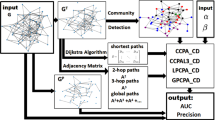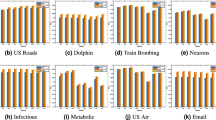Abstract
Link prediction has received a great deal of attention from researchers. Most of the existing researches are based on the network topology but ignore the importance of its preference; for aggregating multiple pieces of information, they normally sum up them directly. In this paper, a path-based probabilistic model is proposed to estimate the potential connectivity between any two nodes. It takes carefully the effective influence of nodes and the dependency among paths between two fixed nodes into account. Furthermore, we formulate the connectivity of two inner-community nodes and that of two inter-community nodes. The qualitative analysis shows that the links between inner-community nodes are more likely to be predicted by the proposed model. The performance is verified on both the multi-barbell network and Lesmis network. Considering the proposed model’s practicability, we develop an algorithm that iterates over the adjacent matrix to simulate paths of different lengths, with the parameters automatically grid-searched. The results of the experiments show that the proposed model outperforms competitive methods.








Similar content being viewed by others
Explore related subjects
Discover the latest articles, news and stories from top researchers in related subjects.Change history
20 July 2021
A Correction to this paper has been published: https://doi.org/10.1007/s13042-021-01350-4
Notes
All pictures of networks in this paper are drawn by Gephi which is a software for the visualization of graphs and networks (http://networkrepository.com/index.php). Fruchterman Reingold [32] is used to generate the network layout, and the nodes in a network are colored by their modularities.
These real networks can be downloaded at http://networkrepository.com/index.php.
References
Adamic L, Adar E (2003) Friends and neighbors on the web. Soc Netw 25(3):211–230
Aziz F, Gul H, Muhammad I, Uddin I (2020) Link prediction using node information on local paths. Phys Stat Mech Appl 557:124980
Baird D, Ulanowicz R (1989) The seasonal dynamics of the Chesapeake bay ecosystem. Ecol Monogr 59(4):329–364
Barabäsi A, Albert R (2009) Emergence and scaling in random networks. Science 106(52):22073–22078
Batagelj V, Mrvar A (2000) Some analyses of Erdös collaboration graph. Soc Netw 22(2):173–186
Brin S, Page L (1998) The anatomy of a large-scale hypertextual web search engine. Comput Netw ISDN Syst 30(1):107–117
Cheng H, Ning Y, Yin Z, Yan C, Liu X, Zhang Z (2018) Community detection in complex networks using link prediction. Mod Phys Lett B 32(3):1850004
Curado M (2020) Return random walks for link prediction. Inf Sci 510:99–107
Fouss F, Pirotte A, Renders J, Saerens M (2007) Random-walk computation of similarities between nodes of a graph a graph with application to collaborative recommendation. IEEE Trans Knowl Data Eng 19(3):355–369
Freeman L (1977) A set of measures of centrality based on betweenness. Sociometry 40(1):35–41
Gao H, Ji S (2019) Graph u-nets. In: International conference on machine learning, pp 2083–2092
Goyal P, Ferrara E (2017) Graph embedding techniques and applications and and performance: a survey. Knowl Based Syst 151:78
Grover A, Leskovec J (2016) node2vec: Scalable feature learning for networks. In: Proceedings of the 22nd ACM International conference on knowledge discovery and data mining
Guo J, Shi L, Liu L (2019) Node degree and neighbourhood tightness based link prediction in social networks. In: 2019 9th International conference on information science and technology (ICIST), IEEE, pp 135–140
Hanely J, McNeil B (1982) The meaning and use of the area under a receiver operating characteristic (ROC) curve. Radiology 143:29–36
Hasan MA, Zaki M (2011) A survey of link prediction in social networks. In Social network data analytics. Springer, New York, pp 243–275
Jalili M, Orouskhani Y, Asgari M, Alipourfard N, Perc M (2017) Link prediction in multiplex online social networks. R Soc Open Sci 4(2):160863
Jeh G, Widom J (2002) Simrank: a measure of structural-context similarity. In: Eighth ACM SIGKDD International conference on knowledge discovery and data mining, pp 538–543
Klein D, Randic M (1993) Resistance distance. J Math Chem 12(1):81–95
Lebedev A, Lee J, Rivera V, Mazzara M (2017) Link prediction using top-k shortest distances. In: British International conference on databases, Springer, pp 101–105
Li Y, Luo P, Fan Z, Chen K, Liu J (2017) A utility-based link prediction method in social networks. Eur J Oper Res 260(2):693–705
Lichtenwalter R, Lussier J, Chawla N (2010) New perspectives and methods in link prediction. In: Proceedings of the 16th ACM SIGKDD international conference on Knowledge discovery and data mining, pp 243–252
Liu W, Lü L (2010) Link prediction based on local random walk. Europhys Lett 89(5):58007
Liu W, Gong M, Wang S, Ma L (2018) A two-level learning strategy based memetic algorithm for enhancing community robustness of networks. Inf Sci 422:290–304
Lorrain F, White H (1977) Structural equivalence of individuals in social networks. Soc Netw 1(1):67–98
Lü L, Zhou T (2011) Link prediction in complex networks: a survey. Phys A Stat Mech Appl 390(6):1150–1170
Lü L, Jin C, Zhou T (2009) Similarity index based on local path for link prediction of complex networks. Phys Rev E 80(4):046122
Ma C, Zhou T, Zhang H (2016) Playing the role of weak clique property in link prediction: a friend recommendation model. Sci Rep 6:1
Mallek S, Boukhris I, Elouedi Z, Lefevre E (2017) Evidential k-nn for link prediction. In: European conference on symbolic and quantitative approaches to reasoning and uncertainty, Springer, pp 201–211
Manshad M, Meybodi M, Salajegheh A (2020) A new irregular cellular learning automata-based evolutionary computation for time series link prediction in social networks. Appl Intell 51:1–14
Martínez V, Berzal F, Cubero J (2016) A survey of link prediction in complex networks. ACM Comput Surv (CSUR) 49(4):1–33
Mennens R, Scheepens R, Westenberg MA (2019) A stable graph layout algorithm for processes. Comput Graphics Forum 38(3):725–737
Mering CV, Krause R, Snel B, Cornell M, Stephen GO, Fields S, Bork P (2002) Comparative assessment of large-scale data sets of protein–protein interactions. Nature 417:399–403
Ou M, Peng C, Jian P, Zhang Z, Zhu W (2016) Asymmetric transitivity preserving graph embedding. In: The 22nd ACM SIGKDD International conference
Qian Y, Jiye L, Witold P, Dang C (2010) Positive approximation: an accelerator for attribute reduction in rough set theory. Artif Intell 174(9–10):597–618
Rossi R, Ahmed N (2015) The network data repository with interactive graph analytics and visualization. In: Proceedings of the twenty-ninth AAAI conference on artificial intelligence. http://networkrepository.com
Sarukkai R (2000) Link prediction and path analysis using Markov chains. Comput Netw 33(1–6):377–386
Soffer S, Vazquez A (2005) Network clustering coefficient without degree-correlation biases. Phys Rev E 71(5):057101
Sun B, Shen H, Gao J, Ouyang W, Cheng X (2017) A non-negative symmetric encoder–decoder approach for community detection. In: Proceedings of the 2017 ACM on conference on information and knowledge management. https://doi.org/10.1145/3132847.3132902
Tian Y, Li H, Zhu X, Tian H (2019) Link prediction based on combined influence and effective path. Int J Mod Phys B 33(22):1950249
Tong H, Faloutsos C, Pan J (2006) Fast random walk with restart and its applications. In: Sixth international conference on data mining (ICDM’06), IEEE, pp 613–622
Šubelj L, Bajec M (2011) Robust network community detection using balanced propagation. Eur Phys J B 81(3):353–362
Wang D, Peng C, Zhu W (2016a) Structural deep network embedding. In: the 22nd ACM SIGKDD International conference
Wang L, Ren J, Xu B, Li J, Luo W, Xia F (2020) Model: Motif-based deep feature learning for link prediction. IEEE Trans Comput Soc Syst 7(2):503–516
Wang P, Xu B, Wu Y, Zhou X (2015) Link prediction in social networks: the state-of-the-art. Sci China Inf Sci 58(1):1–38
Wang X, Cui P, Wang J, Pei J, Zhu W, Yang S (2017) Community preserving network embedding. In: Thirty-first AAAI conference on artificial intelligence
Wang Z, Liang J, Li R, Qian Y (2016b) An approach to cold-start link prediction: establishing connections between non-topological and topological information. IEEE Trans Knowl Data Eng 28(11):2857–2870
Watts D, Steven H (1998) Collective dynamics of small world networks. Nature 393:440–442
White J, Southgate E, Thomson J et al (1976) The structure of the ventral nerve cord of Caenorhabditis elegans. Philos Trans R Soc Lond 275(938):327
Xie F, Chen Z, Shang J, Feng X, Li J (2015) A link prediction approach for item recommendation with complex number. Knowl Based Syst 81(C):148–158
Xie Y, Zhou T, Wang B (2008) Scale-free networks without growth. Phys A Stat Mech Appl 387(7):1683
Xie Y, Gong M, Wang S, Yu B (2018) Community discovery in networks with deep sparse filtering. Pattern Recognit 81:50–59
Yao Y, Zhang R, Yang F, Tang J, Yuan Y, Hu R (2018) Link prediction in complex networks based on the interactions among paths. Phys A Stat Mech Appl 510:52–67
Zhang M, Chen Y (2018) Link prediction based on graph neural networks. In: Advances in Neural information processing systems, pp 5165–5175
Zhao Z, Zheng S, Li C, Sun J, Chang L, Francisco C (2018) A comparative study on community detection methods in complex networks. J Intell Fuzzy Syst 35(1):1077–1086
Zhao Z, Li C, Zhang X, Chiclana F, Enrique HV (2019) An incremental method to detect communities in dynamic evolving social networks. Knowl Based Syst 163:404–415
Zhong Z, Zhang Y, Pang J (2020) Neulp: An end-to-end deep-learning model for link prediction. In: International conference on web information systems engineering, Springer, pp 96–108
Zhu X, Tian H, Cai S (2014) Predicting missing links via effective paths. Phys A Stat Mech Appl 413(11):515–522
Acknowledgements
The authors would like to thank Yayu Zhang, Furong Lu, Honghong Cheng, Jieting Wang and Junjie Ma for their insightful discussions. This work was supported by National Natural Science Foundation of China (nos. 61672332, 61322211, 61432011, 61872226 and U1435212), the Young Scientists Fund of the National Natural Science Foundation of China (Grant no. 61802238). Program for New Century Excellent Talents in University (no. NCET-12-1031), Program for the Outstanding Innovative Teams of Higher Learning Institutions of Shanxi, and Program for the Young San Jin Scholars of Shanxi, the Natural Science Foundation of Shanxi Province (no. 201701D121052), the Research Project Supported by Shanxi Scholarship Council of China (no. 2017023).
Author information
Authors and Affiliations
Corresponding author
Ethics declarations
Conflict of interest
The authors declare that they have no conflict of interest.
Additional information
Publisher's Note
Springer Nature remains neutral with regard to jurisdictional claims in published maps and institutional affiliations.
Rights and permissions
About this article
Cite this article
Ma, G., Yan, H., Qian, Y. et al. Path-based estimation for link prediction. Int. J. Mach. Learn. & Cyber. 12, 2443–2458 (2021). https://doi.org/10.1007/s13042-021-01312-w
Received:
Accepted:
Published:
Issue Date:
DOI: https://doi.org/10.1007/s13042-021-01312-w




